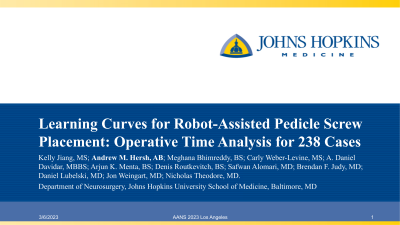The Long-Term Learning Curve of Robot-Assisted Pedicle Screw Placement: Analysis of 1,489 Screws
The Long-term Learning Curve of Robot-assisted Pedicle Screw Placement: Analysis of 1,489 Screws
Friday, April 21, 2023


Andrew M. Hersh, AB (he/him/his)
Student
Johns Hopkins School of Medicine
Baltimore, Maryland, United States
ePoster Presenter(s)
Introduction: Robot-assisted pedicle screw placement is associated with greater accuracy, less radiation, and fewer complications. However, the learning curve required to achieve mastery in robotic spine surgery remains unclear and may differ across robotic platforms.
Methods: The first 245 patients at a tertiary care institution undergoing robot-assisted pedicle screw placement by a single surgeon using the ExcelsiusGPS system were retrospectively reviewed. Operative time learning curve was evaluated by linear regression, cumulative sum analysis, and Tukey tests.
Results: Operative time decreased across the cohort (slope=-0.19, p=0.03). Average operative time decreased after the first 20 cases by 47.1 minutes (p=0.006). Average operative time of post-learning phase cases (cases 21-225) was comparable to the surgeon’s final level of proficiency, as determined by the average operative time of the last 20 cases (cases 226-245) (p=0.25). Sub-analysis of 86 cases for correction of spondylolisthesis confirmed a significant decrease in operative time over time (slope=-0.99, p= < 0.001), with the cumulative sum analysis revealing an inflection point at the 49th case, indicating the case number at which proficiency was attained. Significant reductions in operative time were observed when comparing the first 20 cases to the post-learning cases (p=0.05) and when comparing post-learning cases to the last 20 cases (p < 0.001).
Conclusion : This study illustrates the long-term learning curve of an experienced, fellowship-trained surgeon with robotic spine surgery. Operative time significantly decreased after the initial 20 cases and was comparable with final proficiency levels achieved after 245 cases. Although a variety of surgical operations were performed, analysis of spondylolisthesis cases, which constituted the most common operative indication, illustrated that mastery was achieved after 49 cases.
Methods: The first 245 patients at a tertiary care institution undergoing robot-assisted pedicle screw placement by a single surgeon using the ExcelsiusGPS system were retrospectively reviewed. Operative time learning curve was evaluated by linear regression, cumulative sum analysis, and Tukey tests.
Results: Operative time decreased across the cohort (slope=-0.19, p=0.03). Average operative time decreased after the first 20 cases by 47.1 minutes (p=0.006). Average operative time of post-learning phase cases (cases 21-225) was comparable to the surgeon’s final level of proficiency, as determined by the average operative time of the last 20 cases (cases 226-245) (p=0.25). Sub-analysis of 86 cases for correction of spondylolisthesis confirmed a significant decrease in operative time over time (slope=-0.99, p= < 0.001), with the cumulative sum analysis revealing an inflection point at the 49th case, indicating the case number at which proficiency was attained. Significant reductions in operative time were observed when comparing the first 20 cases to the post-learning cases (p=0.05) and when comparing post-learning cases to the last 20 cases (p < 0.001).
Conclusion : This study illustrates the long-term learning curve of an experienced, fellowship-trained surgeon with robotic spine surgery. Operative time significantly decreased after the initial 20 cases and was comparable with final proficiency levels achieved after 245 cases. Although a variety of surgical operations were performed, analysis of spondylolisthesis cases, which constituted the most common operative indication, illustrated that mastery was achieved after 49 cases.
